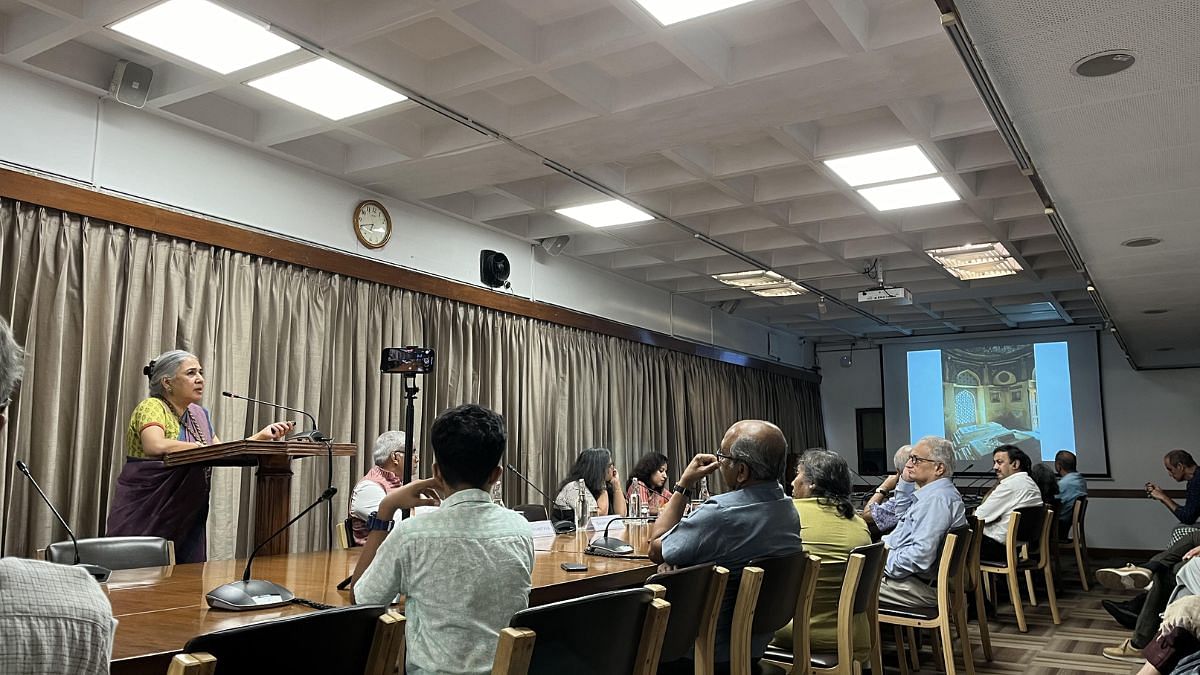New Delhi: There’s much more to Mehrauli Archaeological Park than its usual cluster of favourites, like the Tomb of Balban. And for it to survive, if not thrive, every inch of the park needs to be treated equally. But a bevy of administrative and logistical challenges stand in the way–– the park is caught between the Archaeological Survey of India, the Delhi Development Authority, the New Delhi Municipal Council, and the Waqf board.
“The park is protected under the Delhi building bylaws and heritage laws. It also has municipal-level protection,” said heritage conservationist and historian Swapna Liddle at a talk at Delhi’s India International Center (IIC). “Whoever can prove they own a structure, can. Waqf has brought out notifications which notify some (parts of the park) as Waqf property.”
There’s a polluted stream, which is effectively an open drain running through the archaeological park’s hundreds of acres. Mehrauli village is underutilised. Archaeological ruins remain buried, and even the much-adored Rajon ki Baoli, which Liddle describes as Delhi’s “most impressive baoli,” is overrun with sewage water.
“When we see only its Instagrammable parts, we forget that there’s a lot more. We can’t look at monuments as being divorced from their larger setting,” she said.
At the talk, Debashree Banerjee, secretary of the water resources department, and tourism secretary Niharika Rai delved into various categories of problems that plague the Mehrauli Archaeological Park. These issues have been around in some form or the other since the 11th century. They also stressed the need to reevaluate the currently myopic approach to conservation –– it fails to go beyond mass appeal and see the park as a cohesive, dynamic entity.

“We need an anchor for the park. Normally, I’d say the urban local body must be the anchor. But in this case, the DDA is the principal landowner and the Development Planning Agency,” said Banerjee. “It needs to have a management committee which brings together multiple stakeholders including the people who live around the park.”
Solutions were sandwiched between problems, though there are homegrown examples of successful revitalisation. Sunder Nursery, after being brought under the Aga Khan Trust for Culture, has also led to the revitalisation of the entire Nizamuddin Basti area, which was once home to about a hundred monuments. Today, sixty survive.
Architect Anuj Srivastava, who was moderating the talk, argued that the Sunder Nursery model has its pitfalls. “Is a manicured park the only way forward?” he asked.
However, according to Yogesh, a Nizamuddin resident and audience member, the Mehrauli Archaeological Park and Sunder Nursery could have the same trajectory. “What it needs is archaeological commitment. Everything came back,” he said. The water table in the Basti has gone up, and it’s home to the new Humayun’s Tomb Museum.
Also read: Humayun pioneered architecture, art, and astronomy. Now he’s got his own museum
The ASI barrier
What’s also jarring about the Mehrauli Archaeological Park’s neglect is that it’s right next door to the Qutub Minar –– a historical and archaeological marvel that is treated as such, if lines of tourists are anything to go by. The distinction, according to Liddle, is purely academic. The Qutub Minar is a world heritage site, while the park is not.
“There are huge tourism problems. Even when we want to do something, we can’t because we don’t know who owns that particular area,” said Niharika Rai. According to her, the park’s reinvigoration needs to take from its tourism prospects. The area around which Quli Khan’s tomb is located has now started playing host to concerts. A sound and light show in Zafar Mahal, in Mehrauli village, is in the works. But there’s a hurdle always looming in the backdrop –– the ASI.
“The ASI believes that even if you do an event a hundred or two hundred metres away, the boundary wall will collapse,” she said, only half-joking.
Since 2022, ASI has been encouraging film producers to come and shoot in and around the park. It’s essentially to break away from traditional Delhi cityscape scenes like the Red Fort, Humayun’s Tomb, and the Qutub Minar, and give the park some much-needed star power.
What is also necessary for the success of the park as a public hotspot is the involvement of those who live in the Mehrauli village.
“The most important thing we have to realise is that whether it’s heritage development or any other kind, the people of the vicinity need to be included,” she said. “They’re the best people to help because they’ve grown in the area.” It would also help boost employment, the historian added.
Audience members, who appeared to consist primarily of architecture and history enthusiasts, came with their own grouses. Redevelopment and tourism boosting have come with a price. In the case of Qutub Minar, one architect spoke about how sketching at the site is not allowed anymore.
It was all attributed to the paternalistic, overprotective attitude of the ASI. “If it’s sealed, they think they’ve done their protection. People of the city need heritage so they can learn from it,” the architect said.
(Edited by Ratan Priya)






